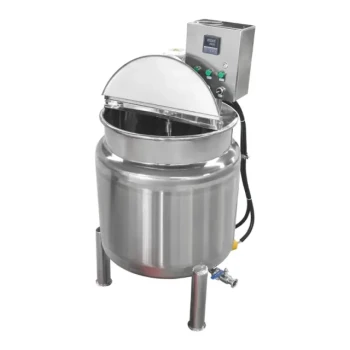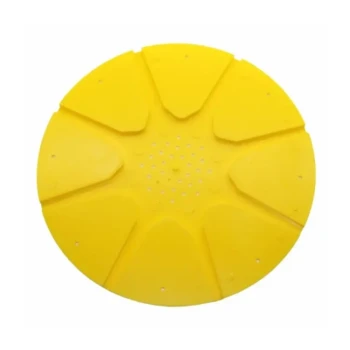Royal jelly is a specialized, milky secretion produced by young worker honeybees to serve as the exclusive food source for the colony's queen. It is created when worker bees combine honey and bee pollen with enzymes from glands in their throats. This process results in a nutrient-dense substance that fuels the queen's development and lifelong vitality.
Royal jelly is not a type of honey, but a unique glandular product specifically engineered by worker bees. Its sole purpose is to provide the intense nutrition required to develop and sustain a queen, making it the defining factor that separates a queen from a regular worker bee.

The Production Process: From Pollen to Power
Royal jelly's creation is a precise biological process that happens inside the body of a worker bee. Understanding this is key to appreciating its unique role in the hive.
A Glandular Secretion
Unlike honey, which is stored nectar, royal jelly is a secretion. It is produced in the hypopharyngeal glands, located in the heads of young worker bees (often simplified as their "throats").
Combining Raw Ingredients
Worker bees consume and process two primary hive resources: honey (for carbohydrates) and bee pollen (for proteins and fats).
The Enzymatic Transformation
Within the glands, special enzymes transform these raw ingredients into a completely new substance. This results in the thick, milky, and protein-rich royal jelly.
The Purpose of Royal Jelly: Creating Royalty
The entire function of royal jelly is centered on the creation and maintenance of a single, vital member of the colony: the queen.
The Deciding Factor for Larvae
All female bee larvae are fed royal jelly for the first few days of their lives. However, the larvae chosen to become queens are fed royal jelly exclusively and in massive quantities throughout their development.
Fueling the Queen's Life
This special diet is the sole trigger for the development of queen morphology, including her larger size and reproductive capabilities. It remains her only source of nutrition for her entire life, fueling her ability to lay thousands of eggs per day.
The Composition of Royal Jelly
The substance is a complex mixture designed for maximum biological impact, setting it apart from any other food source in the hive.
Primary Components
Royal jelly is primarily composed of water, proteins, and sugars. It contains unique proteins and fatty acids not found in the same concentrations elsewhere.
A Rich Source of Nutrients
It is also a dense source of vitamins and minerals. The references confirm the presence of B vitamins (B1, B2, B6), vitamins C and E, and essential minerals like calcium, iron, and zinc.
Understanding the Key Distinctions
It is common to confuse royal jelly with other substances from the hive. Clarifying these differences highlights its specific function.
Royal Jelly vs. Honey
Honey is a carbohydrate-rich food made from plant nectar. It is stored as a long-lasting energy source for the entire adult bee colony. Royal jelly is a protein-rich secretion fed directly to the queen and young larvae for growth and development.
Royal Jelly vs. Bee Pollen
Bee pollen is the raw, unprocessed protein source collected from flowers. Royal jelly is the highly processed, enzyme-enriched substance created by worker bees from bee pollen and honey.
How to Apply This Knowledge
Understanding royal jelly is fundamental to understanding the structure and survival of a honeybee colony.
- If your primary focus is bee biology: Recognize that royal jelly is the biochemical tool that dictates whether a larva becomes a short-lived worker or a long-lived queen.
- If your primary focus is hive nutrition: View royal jelly as the ultimate superfood of the hive, reserved exclusively for royalty, while honey and bee bread are the staples for the general population.
Ultimately, royal jelly is the biological mechanism that ensures the reproductive health and continuation of the entire honeybee colony.
Summary Table:
| Aspect | Description |
|---|---|
| What It Is | A milky, protein-rich secretion from young worker bees' glands. |
| Primary Use | Exclusive food for the queen bee and young larvae. |
| Key Components | Proteins, B vitamins (B1, B2, B6), vitamins C & E, calcium, iron, zinc. |
| How It's Made | Worker bees process honey and pollen with enzymes in their hypopharyngeal glands. |
| Main Function | Triggers queen bee development and sustains her reproductive capabilities. |
Equip Your Apiary with the Best Supplies from HONESTBEE
Understanding the intricate biology of your bees is the first step to a thriving apiary. The next is ensuring they have the highest quality equipment and supplies. HONESTBEE is your trusted wholesale partner, supplying commercial apiaries and beekeeping equipment distributors with durable, reliable products that support every stage of the beekeeping process—from hive management to harvesting.
Let's build a stronger future for beekeeping together.
Contact HONESTBEE today to discuss your wholesale needs and discover how our products can contribute to the health of your hives and the success of your business.
Visual Guide

Related Products
- Heavy Duty Stainless Steel Queen Bee Catcher Clip
- Long Langstroth Style Horizontal Top Bar Hive for Wholesale
- Food Grade Plastic Honey Bucket Pail for Beekeeping
- Stainless Steel Honey Press Wax Press with Tank
- Economy Honey Homogenizer Mixer and Melting Machine for Beekeeping
People Also Ask
- Why are Posca pens commonly used for marking queen bees? The Safest, Most Durable Method for Beekeepers
- Why are queen clipping scissors used? A Beekeeper's Guide to Swarm Control
- What is the function of queen clip catchers? Safely Handle Your Queen Bee
- What are the considerations for using gloves in beekeeping? Balance Protection and Dexterity for Hive Success
- Why should beekeeping gloves fit snugly but not tightly? The Key to Safety & Dexterity



















